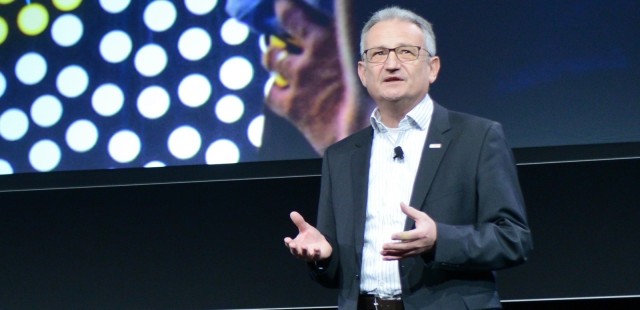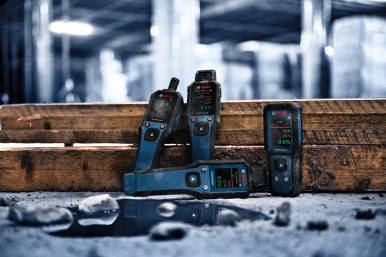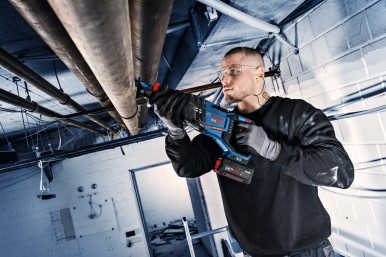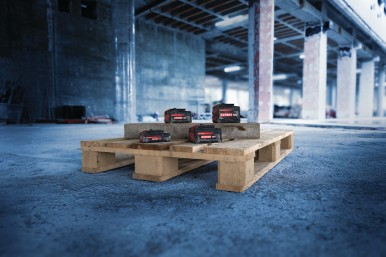Good morning, everyone. And welcome to the Bosch press conference.
I’m very pleased to be joining you here today.
The video we just watched presents our view of the Internet of Things. This is the fifth year that Bosch has been present at CES. And I can tell you that today, we are more enthusiastic than ever about the changes the IoT is bringing.
In an increasingly connected world, people expect technologies to make everyday life even simpler, more convenient, and safer. Above all, they want them to be tailored to their individual needs. This is why we see personalization as the next big connectivity trend. And we are focusing on coming up with personal, emotional, and responsive solutions. In short, we want to offer smart products and services that act as assistants and partners.
In a moment, I will give you some examples of what I mean. But first, let me say a few words about Bosch.
Over the course of our 130-year history, we’ve always worked to come up with innovations that are “Invented for life”. Our company founder Robert Bosch once said: “None of us should ever be satisfied with what has been achieved, but should always endeavor to do better.” When it comes to the IoT, doing better means – more than ever – figuring out how technology can offer real benefits through connectivity – for all of us. So today, our innovations are “Invented for a – Simply.Connected. – life.”
The four “CES Innovation Awards” we have received for three of the solutions on display this year clearly show our ability to create such products. Our Integrated Connectivity Cluster for two-wheelers even took the Best of Innovation Award in the In-Vehicle Audio and Video category. It is a fine example of how technology can make motorcycles safer and more comfortable. This system combines all the motorcycle’s instrumentation on a single display, making it possible for riders to use their smartphone safely – and this in all weather conditions.
In the years to come, demand for innovative solutions like these will continue to increase. By 2020, the global IoT market is expected to be worth some 250 billion dollars, a third of which will be generated in the Americas. The U.S. ranks among the top five countries with regard to the number of IoT devices. So it’s no surprise that it is one of the most important IoT markets for us
We are in a strong position to tap this potential. From mobility solutions, industrial technology to energy and building technology as well as consumer goods, we are active in many fields. And we are able to connect these domains with one another. In recent years, we’ve been working diligently to become one of the world’s key players in the realm of IoT. We are doing this for two reasons. First, connectivity is allowing us to enhance our traditional business. Second, it is opening the door to completely new possibilities. In fact, our target is to make all of our electronic products connected by 2020. This will also mean offering every product with a service package.
What’s more, only very few industrial enterprises can draw on software and sensor technology know-how to the extent we can. With the launch of the Bosch IoT Cloud in Germany last year, we have added the final piece of the puzzle to our software expertise. This year, we plan to launch our own cloud here in the U.S., too.
With regard to personalization, sensors deserve a special mention. Bosch is the global market leader when it comes to microelectromechanical sensors – MEMS for short. With these, we can make things “feel” what is going on around them: sensors are the eyes and ears of millions of devices, from smartphones and tablets to vehicles. They can help save lives and energy, and make driving more comfortable.
At this year’s CES, we are unveiling our smallest and best performing pressure sensor. It can do a number of things, including stabilizing drones even better. It can also measure calorie expenditure more accurately in wearables and identify whether you are walking upstairs or downstairs in a step-tracking application. I bet you’ll be walking around CES quite a lot in the coming days – why not get your workout done by visiting our booth?
Everything I’ve mentioned so far shows that we are making a major contribution to shaping the innovations of a connected world. Our strong global R&D network plays a decisive role here. To make sure our associates have the freedom they need to innovate, Bosch consistently promotes an entrepreneurial spirit within the walls of the company, for instance with the Bosch start-up platform. The platform has seen small units and companies emerge that have significantly shortened the time between an idea and a marketable product.
One example of such a company is Mayfield Robotics. Based in Silicon Valley, Mayfield illustrates how Bosch supports small, dynamic start-ups alongside its established business. Mayfield has been quietly developing a home robot named Kuri since 2015. It premiered at “CES Unveiled” just yesterday. Kuri is chock-full of technology, from speakers, microphones, and a camera, to touch sensors and mapping sensors. This little guy can interact with you, almost like a family member.
His job is to entertain, bring joy and help people in their everyday lives. When the family is out, he can patrol the house and make sure everything is okay. If he hears a loud noise, he can inform you on your smartphone. Kuri can even alert you when your children arrive home from school while you are still stuck in traffic. Over time, he learns how to move about the house and remembers the faces of people he sees every day. When he sees the mother, he reacts differently than when he runs into her young son around the house. Kuri combines mobility, awareness and personality in a way that can bring an inspiring spark of life to your home.
We at Bosch are excited that Kuri will be launched in the U.S. just in time for next Christmas. So if your loved ones were disappointed with the gifts you just gave them, you’ve already got an idea for this year! If you would like to arrange a one-on-one demonstration appointment with Kuri, let us know after the press conference.
Kuri is one example that shows how the IoT is getting personal, and how connectivity is turning things into partners and assistants. We see huge potential here. Ultimately, connectivity is transforming our daily lives. First, it can personalize solutions even more. Second, it can also enhance existing products by enabling them to take on additional tasks. And third, innovations are increasingly designed specifically to interact with their users. Who doesn’t want personal assistants that make life safer, easier, and more convenient? Someone who takes over tasks and gives you more time for yourself.
According to a recent study, more than 60 percent of respondents is in favor of having intelligent technologies assist them every day. In response to this development, we aim to become our customers’ everyday companion with connected solutions and services. We believe that connectivity is more than just technology. It’s part of our lives. So we are working to integrate it in a growing number of ways. The first is by improving mobility.
Improving mobility: making the car your assistant and partner
The global market for connected mobility is expected to grow nearly 25 percent annually over the next five years alone. As connectivity progresses, cars and driving will make huge strides forward. Vehicles will be connected to their surroundings, and even driving themselves.
Here at CES, you can experience this in our new show car. It demonstrates how you can communicate with your car, and how your car interacts with your smart home and the smart city. In short, it’s about creating a seamless connection between all spheres of life and a new passenger environment.
The show car also features a range of innovative technologies that will personalize vehicle applications even more. I am especially looking forward to experiencing the new Drive Monitor Camera. Once you are in the driver’s seat, you will notice that the camera automatically adjusts the car’s settings to your personal preferences. It can set the position of the steering wheel and mirrors as well as the temperature in the car. The technology can even select the right music to reflect your taste. Importantly, it can also monitor your state and issue warnings when you risk falling asleep or are distracted. This helps avoid critical situations and save lives.
The ultra-haptic gesture control is another premiere you can experience in the show car. And let me tell you, this is very cool. The technology uses ultrasound sensors that let you feel whether your hand is in the right spot when controlling the human-machine interface system. At the same time, it gives you feedback on the gestures performed.
Once highly automated driving becomes reality, the car will be a third living space next to the home and the office – a personal assistant on four wheels. This will have a number of benefits. Imagine having enough time to watch all planned eight seasons of Game of Thrones. According to our brand new "Connected Car Effect" study, frequent drivers in the U.S., China, and Germany could do just that: Thanks to highly automated driving, they could save almost 100 hours annually by 2025. And if you’re not into TV series, I can think of many other ways to use that time. The study also states that integrating smartphones into vehicles can reduce driver distraction significantly and thus also the number of fatal accidents by about 700 per year alone in the U.S., also by 2025. Not only will this save drivers time, it will also make driving safer.
And speaking of safety, last year, we introduced a true guardian angel on this stage: our Retrofit eCall. Once plugged into a car’s cigarette lighter, any car can sense a collision and automatically send the relevant information to a service center. In North America, Arity, owned by Allstate Insurance Company, partnered with Bosch to pilot this accident detection system as ‘Accident Aid’ with Allstate customers. Depending on the severity of the accident, the service center either contacts the driver directly or notifies the nearest emergency services and this is just the start to Arity’s plans to revolutionize driver safety, connectivity and value.
Shaping the cities of the future
But what is a car with brains without a smart city to match it? Connectivity is also shaping the cities of the future. There is no question that smart cities also call for innovative mobility concepts. On average, it takes up to 30 minutes and almost three miles just to find an empty parking space in a city. To cut the time urban drivers spend looking for a space, and thus also to decongest the roads, we are cooperating with Mercedes-Benz and other OEMs. With a concept we call community based parking, the aim here is to turn the car into a parking spot locator – an assistant that speaks with the road and helps you find a free space in no time. This is good for your nerves and your wallets, and it makes parking a piece of cake. We’re also planning pilot projects to test the technology in the U.S. this year as you can see.
By 2050, more than six billion people worldwide will live in urban areas. With the movement of populations to more dense, metropolitan areas, the concept of personalized services will play a critical role in enhancing their quality of life. An example of urban areas adopting the concept of personalized services, is The Shipyard Communities in San Francisco. The new communities are being built on the former site of a Navy shipyard and the Candlestick Park stadium. In collaboration with FivePoint, the master developer of The Shipyard Communities, we are developing a Smart Community App for the residents. The app provides localized, real-time information on public transport as well as access to intelligent surveillance solutions. There are also plans for future-oriented solutions for efficient traffic management and smart buildings.
Our new Vivatar app is another example of a service that enhances life in the city. It acts as a digital guardian angel when you are out alone – jogging in the dark, or heading home on foot late at night, for instance. People can use it to contact friends and family and be digitally “escorted” home via GPS.
Making homes smarter
Even within the walls of your home, you can be sure that Bosch is working to make your house at least as smart as your car and the city. We see a great deal of potential here, too. According to recent estimates, around 15 percent of all households worldwide, some 230 million homes, will be equipped with smart home technology by the end of this decade.
Making homes smarter not only means making your everyday life more comfortable. The smart home also saves energy and money, and helps keep you safe. Again, connectivity is the name of the game. It’s turning your entire home into a personal assistant, and is making a broad range of devices your partners in the household.
Mykie – short for "my kitchen elf" – is a good example of this, and Mykie is also being showcased here at CES. The personal assistant for the kitchen presents a good look at the future: it shows how connectivity makes it possible to develop products specifically designed to interact with you. Mykie helps you cooking with his Smart Recipe Guidance, a voice-controlled step by step guidance through your preferred recipe. Virtual Social Cooking makes it even possible to not only connect with your kitchen, but also with family and friends from all over the world.
Mykie is just one part of the vision that Bosch is developing for the smart home. The Home Connect app allows you to control all major household appliances remotely via your tablet or smart phone. In the future, you’ll be able to choose the right laundry setting from your living room couch; program your coffee machine from the comfort of your bed; or check the contents of your refrigerator from the supermarket.
The idea of accessing your home while you are on vacation also has a certain appeal. With the help of new technologies like the Bosch 360 indoor camera and the Eyes Outdoor, you can keep an eye on your home at all times. The Eyes Outdoor is more than just a camera. It also features built-in lights, motion sensors, and an intercom.
Other smart home solutions are taking on additional tasks to make your home even safer. For example, our Twinguard smoke detector plays several roles. Besides detecting smoke and sending the homeowner a message over the app, it can also measure air quality. A clever additional function allows the detector’s siren to be used to scare off unwelcome guests.
Connected industry: the industrial Internet of Things
At home and beyond, today’s consumers are demanding innovative products and services at ever-shorter intervals. To keep up, manufacturers need to respond with flexible, networked, and smart factories. This brings me to the fourth aspect of our view on the IoT: connected industry, also known as the industrial Internet of Things – or IIoT. Bosch is already a lead user and provider of connected industry technologies.
And we see many opportunities here. The global market for retrofit solutions alone is worth billions. Today, many of the machines used in skilled trades or manufacturing do not meet the essential requirements of connected industry: for example, they lack sensors, software, and connections to companies’ IT systems. At CES, Bosch is presenting the new IoT gateway. It shows how operators of older manufacturing systems can connect their machines, and monitor them in real time. This enables predictive maintenance, which in turn increases productivity and thus saves costs.
Together with partners in all three major economic regions, and especially with the Industrial Internet Consortium, we are working to further shape the IIoT. Just recently, our Bosch Software Innovations subsidiary entered into a partnership with GE Digital. This will be a decisive contribution to interoperability and open-source collaboration.
The concept of personal assistants has also made its way into industrial processes. The APAS mobile production assistants are an excellent example of this. Designed especially for use in IIoT applications, they offer strong support in automated production. While the robots take on menial tasks, their human counterparts can assume decision-making and management responsibilities. And here at CES, APAS is on hand to help anyone with a sweet tooth: if you’d like some cotton candy or a cup of coffee, the robot is serving it up at our booth in Central Hall. Another good reason to pay us a visit.
Conclusion
This brings me to the end of my speech. As I’ve shown you today, personalization is the next level of connectivity – and Bosch is driving it forward – through all spheres of life. We are coming up with personalized products and services, enhancing existing products to take on additional tasks, and developing personal assistants and partners for our customers. In doing so, we are contributing to improving quality of life.
But please, come and see for yourselves. You can witness the benefits of Simply.Connected. Bosch technologies first-hand at our booth in Central Hall [#14128] this week.
Thank you.





